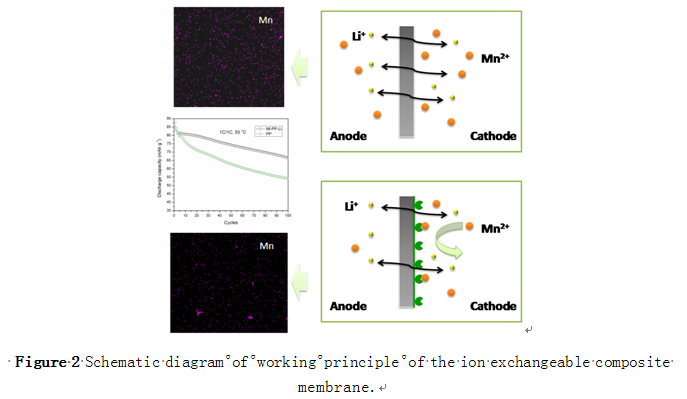Separators with high reliability and security are in urgent demand for the advancement of high performance lithium ion batteries. Teamed with Prof. Xianfeng Li’s group at Division of energy storage, Dalian Institute of Chemical Physics, Chinese Academy of Sciences (CAS), Prof. Zhaoping Liu’s group at the Ningbo Institute of Materials Technology & Engineering (CNITECH), Chinese Academy of Sciences (CAS) developed a new and practical polyether imide (PEI) based porous membrane with three-dimension heat-resistant skeleton and high curvature pore structure as a new separator candidate (Figure 1). The PEI based separator owned high porosity (~70%). And the ambient ion conductivity could reach 8.8×10-4 S cm-1, which is much higher than that of commercial PE separator (1.2×10-4 S cm-1). The unique material properties combining with the well-developed structural characteristics enable the 3D porous skeleton to own several favorable properties, including superior thermal stability, good wettability with liquid electrolyte, high ion conductivity and internal short-circuit protection function, etc. This work has been published on Scientific Reports 2015, DOI:10.1038/srep08255.
With mutual cooperation, a kind of composite membrane with ultra-thin ion exchangeable layer (Figure 2) was then designed as separator for lithium ion battery with manganese-based cathode material. The ion exchangeable layer gave enhanced thermal stability, improved wettability. The lithium ion transference number of the composite membrane reached 0.74. Meanwhile, the composite membrane features with Mn2+ capture function originated from the ion exchanging process between the –SO3-Li+ and Mn2+, especially at high temperature.The composite membrane features will help to alleviate the capacity decay of lithium ion batteries effectively which has been proved.After 100 cycles at 1 oC and 55 oC, the capacity retention rate for the full cells containing the PP separator and themodified separator is 61.7% and 78.6%, respectively. This work has been published on Journal of Materials Chemistry A(DOI: 10.1039/C4TA06908K.
Besides, Prof. Zhaoping Liu’s group also fabricated a kind of polyimide (PI) matrix enhanced cross-linked gel separator by a simple dip-coating and heat treatment method. The PI nonwoven substrate could provide high-temperature thermal stability for the gel separator under high temperature, and the cross-linked gel part could yield enhanced affinity with liquid electrolyte. The gel separator shows better cyclability and rate capability than the traditional PP separator, implying a promising potential application in high power and high safety lithium ion batteries. This work could be referred to Journal of Materials Chemistry A 2014, 2, 9134–9141 and Journal of Power Sources 2014, 271, 134-142
For 5 V lithium ion batteries, Prof. Zhaoping Liu’s group developed a kind of Lithium ionic conducting glass based inorganic-organic composite separator.Compared with the pristine PP separator, the composite separator owns enhanced thermal stability and higher ion conductivity, which gave the LiNi0.5Mn1.5O4 based 5 V lithium ion batteries higher C-rate capacity. This work was published on Journal of Power Sources 2015, 273, 389-395


Prof Zhaoping Liu: liuzp@nimte.ac.cn
Research Group Url: http://english.nimte.cas.cn/rh/rd/newenergy/battery/
All Images by ![]()

